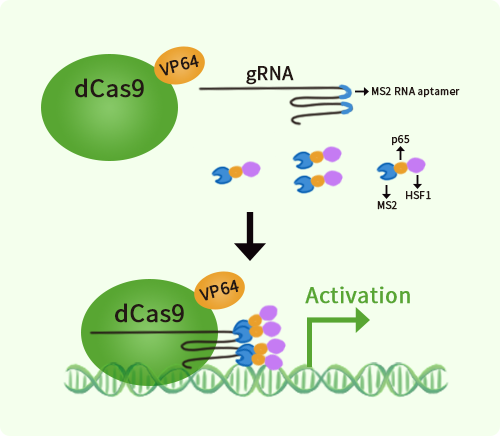Human E2F1 activation kit by CRISPRa
CAT#: GA101308
E2F1 CRISPRa kit - CRISPR gene activation of human E2F transcription factor 1
Find the corresponding CRISPRi Inhibitor Kit
USD 1,290.00
2 Weeks*
Specifications
| Product Data | |
| Format | 3gRNAs, 1 scramble ctrl and 1 enhancer vector |
| Symbol | E2F1 |
| Locus ID | 1869 |
| Kit Components | GA101308G1, E2F1 gRNA vector 1 in pCas-Guide-GFP-CRISPRa GA101308G2, E2F1 gRNA vector 2 in pCas-Guide-GFP-CRISPRa GA101308G3, E2F1 gRNA vector 3 in pCas-Guide-GFP-CRISPRa 1 CRISPRa-Enhancer vector, SKU GE100056 1 CRISPRa scramble vector, SKU GE100077 |
| Disclaimer | The kit is designed based on the best knowledge of CRISPa SAM technology. The efficiency of the activation can be affected by many factors, including nucleosome occupancy status, chromatin structure and the gene expression level of the target, etc. |
| Reference Data | |
| RefSeq | NM_005225 |
| Synonyms | E2F-1; RBAP1; RBBP3; RBP3 |
| Summary | 'The protein encoded by this gene is a member of the E2F family of transcription factors. The E2F family plays a crucial role in the control of cell cycle and action of tumor suppressor proteins and is also a target of the transforming proteins of small DNA tumor viruses. The E2F proteins contain several evolutionally conserved domains found in most members of the family. These domains include a DNA binding domain, a dimerization domain which determines interaction with the differentiation regulated transcription factor proteins (DP), a transactivation domain enriched in acidic amino acids, and a tumor suppressor protein association domain which is embedded within the transactivation domain. This protein and another 2 members, E2F2 and E2F3, have an additional cyclin binding domain. This protein binds preferentially to retinoblastoma protein pRB in a cell-cycle dependent manner. It can mediate both cell proliferation and p53-dependent/independent apoptosis. [provided by RefSeq, Jul 2008]' |
Documents
| Product Manuals |
| FAQs |
Resources
Other Versions
| SKU | Description | Size | Price |
|---|---|---|---|
| KN208247 | E2F1 - human gene knockout kit via CRISPR, HDR mediated |
USD 1,290.00 |
|
| KN208247BN | E2F1 - human gene knockout kit via CRISPR, HDR mediated |
USD 1,290.00 |
|
| KN208247LP | E2F1 - human gene knockout kit via CRISPR, HDR mediated |
USD 1,290.00 |
|
| KN208247RB | E2F1 - human gene knockout kit via CRISPR, HDR mediated |
USD 1,290.00 |
|
| KN408247 | E2F1 - KN2.0, Human gene knockout kit via CRISPR, non-homology mediated. |
USD 1,290.00 |
{0} Product Review(s)
Be the first one to submit a review






























































































































































































































































 Germany
Germany
 Japan
Japan
 United Kingdom
United Kingdom
 China
China
